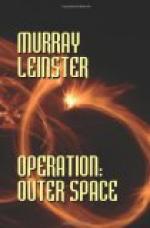Dictating as he worked the pen, Cochrane achieved a pear-shaped mass of ink which was quite the size of a large grape before it fell into his waste-basket. It was the largest he’d made to date. It fell—slow-motion—and splashed—violently—as he regarded it with harried satisfaction.
More time passed. A moon-rocket arrived from Earth. There were new tourists under the thousand-foot plastic dome. Out by the former Mars-ship Jones made experiments with small plastic balloons coated with a conducting varnish. In a vacuum, a cubic inch of air at Earth-pressure will expand to make many cubic feet of near-vacuum. If a balloon can sustain an internal pressure of one ounce to the square foot, a thimbleful of air will inflate a sizeable globe to that pressure. Jones was arranging tiny Dabney field robot-generators with tiny atomic batteries to power them. Each such balloon would be a Dabney field “plate” when cast adrift in emptiness, and its little battery would keep it in operation for twenty years or more.
Baggage came up from Earth for Johnny Simms. It was mostly elephant-guns and ammunition for them. Johnny, as the heir to innumerable millions back on earth, had had a happy life, but hardly one to give him a practical view of things. To him, star-travel meant landing on such exotic planets as the fictioneers had been writing about for a hundred years or so. He really looked upon the venture into space as a combined big-game expedition and escape from Lunar City. And he did look forward, too, to freedom from his family’s legal representative and the constant reminder of ethical and moral values which Johnny preferred happily to ignore.
Film-tape came up, and cameras to use it in. Every imaginable item an expedition to space could use or even might use, was thrust upon Spaceways, Inc. Manufacturers yearned to have their products used in connection with the hottest news story in decades. There was a steady trailing of moon-jeeps from the airlocks of Lunar City to the ship.
The time of lunar sunset arrived—503:30 o’clock, half-past five hundred and three hours. Time was measured from midnight to midnight, astronomical fashion. The great, blazing sun whose streamer prominences, even, were too bright to be looked at with the naked eye—the sun neared and reached the horizon. There was no change in the star-studded sky. There were no sunset colorings. The incandescent brightness on the mountains was not lessened in the least. Only the direction of the stark black shadows shifted.
The glaring sun descended. Its motion was almost infinitely slow. Its disk was of the order of half a degree of arc, and it took a full hour to be fully obscured. And then there was at first no difference in the look of things save that the Mare Imbrium—the solidified, arid Sea of Showers—was as dark as the shadows in the mountains.
They still gleamed brightly. For a very long time the white-hot sunshine glowed on their flanks. The brightness rose and rose, and blackness followed it. At long last only the topmost peaks of the Apennines blazed luridly against a background of stars whose light seemed feeble by comparison.




